TOYOTA SIENNA 2007 Service Repair Manual
Manufacturer: TOYOTA, Model Year: 2007, Model line: SIENNA, Model: TOYOTA SIENNA 2007Pages: 3000, PDF Size: 52.26 MB
Page 1421 of 3000

U151E AUTOMATIC TRANSAXLE – AUTOMATIC TRANSAXLE SYSTEMAX–55
AX
DESCRIPTION
The ATF (Automatic Transmission Fluid) temperature sensor converts the fluid temperature into a
resistance value which is input into the ECM.
MONITOR DESCRIPTION
The ATF temperature sensor converts the ATF temperature to an electrical resistance value. Based on
the resistance, the ECM determines the ATF temperature and detects an open or short in the ATF
temperature circuit or a fault in the ATF temperature sensor.
After running the vehicle for a certain period, the ATF temperature should increase. If the ATF
temperature is below 20
C (68F) after running the vehicle for a certain period, the ECM interprets this as
a fault, and turns on the MIL.
When the ATF temperature is 110
C (230F) or more after 17 minutes of engine cold start, the ECM also
determines this as a fault, turns on the MIL, and stores the DTC.
MONITOR STRATEGY
TYPICAL ENABLING CONDITIONS
All:
Condition (A):
Condition (B):
DTC P0711Transmission Fluid Temperature Sensor "A"
Performance
DTC No. DTC Detection Condition Trouble Area
P0711(A) Both (a) and (b) are detected: (2-trip detection logic)
(a) Intake air and engine coolant temperatures are
more than -10
C (14F) at engine start
(b) After normal driving for over 19 min. and 9 km (6
mile) or more, ATF temp. is less than 20
C (68F)
(B) When engine coolant temp. is less than 35
C (95F)
at engine start, the ATF temp. is 110C (230F) or more
after 17 min. of engine start (2-trip detection logic).Transmission wire (ATF temperature sensor)
Related DTCs P0711: ATF temperature sensor/Rationality check
Required sensors/Components ATF temperature sensor (TFT sensor)
Frequency of operation Continuous
Duration3 sec.: Condition (A), (B), (C)
Continuous.: Condition (D)
MIL operation 2 driving cycles
Sequence of operation None
The monitor will run whenever this DTC is not present. None
TFT sensor circuitNot circuit malfunction
ECT sensor circuitNot circuit malfunction
IAT sensor circuitNot circuit malfunction
ETCSNot circuit malfunction
Time after engine start 18 min. and 20 sec.
Driving distance after engine start 9 km (5.6 mile) or more
IAT (Intake air temperature) (12 sec. after starting engine) -10
C (14F) or more
ECT (12 sec. after starting engine) -10
C (14F) or more
Time after engine start 30 min.
Driving distance after engine start 15 km (9.3 mile) or more
Page 1422 of 3000
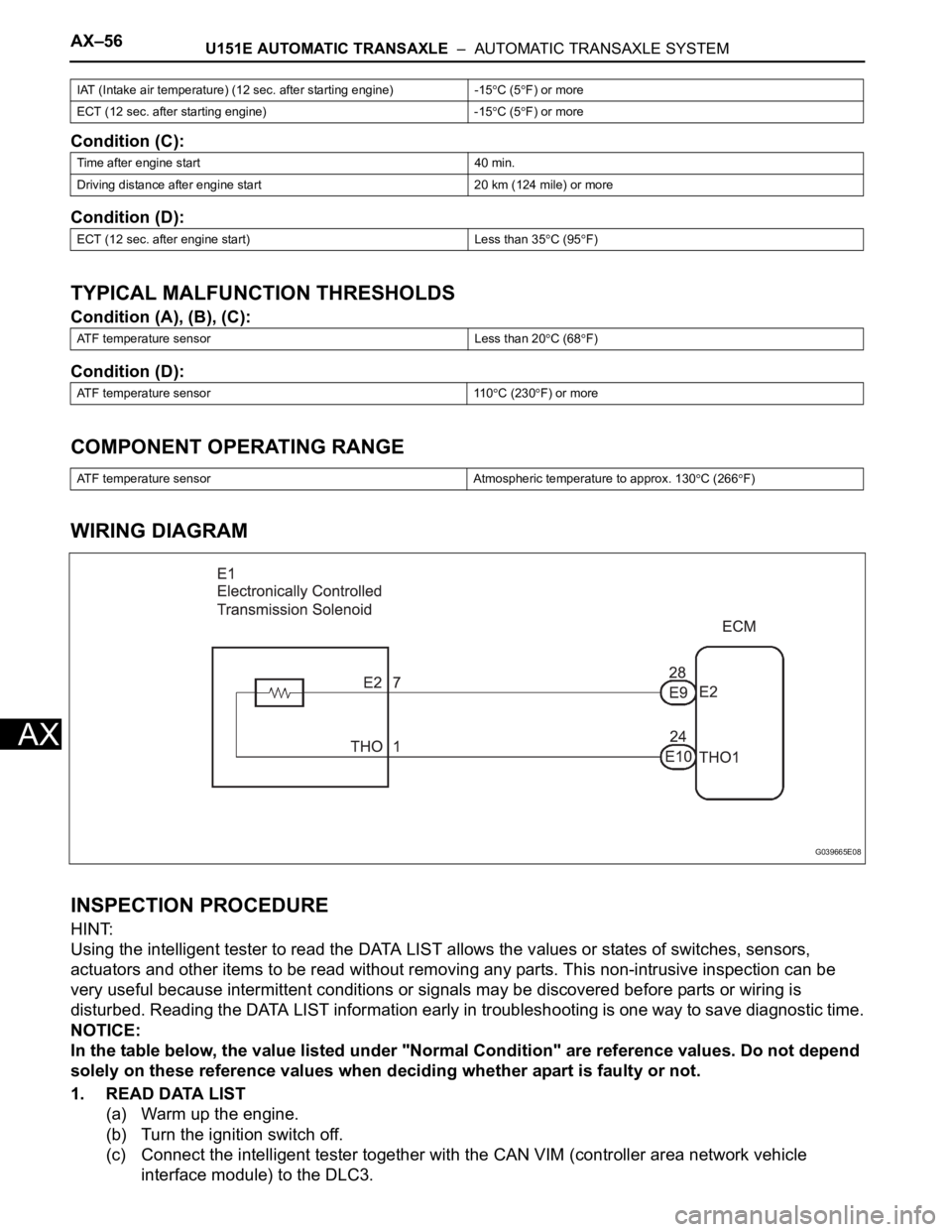
AX–56U151E AUTOMATIC TRANSAXLE – AUTOMATIC TRANSAXLE SYSTEM
AX
Condition (C):
Condition (D):
TYPICAL MALFUNCTION THRESHOLDS
Condition (A), (B), (C):
Condition (D):
COMPONENT OPERATING RANGE
WIRING DIAGRAM
INSPECTION PROCEDURE
HINT:
Using the intelligent tester to read the DATA LIST allows the values or states of switches, sensors,
actuators and other items to be read without removing any parts. This non-intrusive inspection can be
very useful because intermittent conditions or signals may be discovered before parts or wiring is
disturbed. Reading the DATA LIST information early in troubleshooting is one way to save diagnostic time.
NOTICE:
In the table below, the value listed under "Normal Condition" are reference values. Do not depend
solely on these reference values when deciding whether apart is faulty or not.
1. READ DATA LIST
(a) Warm up the engine.
(b) Turn the ignition switch off.
(c) Connect the intelligent tester together with the CAN VIM (controller area network vehicle
interface module) to the DLC3.
IAT (Intake air temperature) (12 sec. after starting engine) -15C (5F) or more
ECT (12 sec. after starting engine) -15
C (5F) or more
Time after engine start 40 min.
Driving distance after engine start 20 km (124 mile) or more
ECT (12 sec. after engine start) Less than 35
C (95F)
ATF temperature sensor Less than 20
C (68F)
ATF temperature sensor 110
C (230F) or more
ATF temperature sensor Atmospheric temperature to approx. 130
C (266F)
G039665E08
Page 1423 of 3000

U151E AUTOMATIC TRANSAXLE – AUTOMATIC TRANSAXLE SYSTEMAX–57
AX
(d) Turn the ignition switch to the ON position.
(e) Turn on the tester.
(f) Select the item "DIAGNOSIS / ENHANCED OBD II / DATA LIST".
(g) According to the display on the tester, read the "DATA LIST".
HINT:
When DTC P0712 is output and OBD II scan tool or intelligent tester output is 150
C (302F),
there is a short circuit.
When DTC P0713 is output and OBD II scan tool or intelligent tester output is -40
C (-40F),
there is an open circuit.
Measure the resistance between terminal THO1 (THO) and body ground.
HINT:
If a circuit related to the ATF temperature sensor becomes open, P0713 is immediately set (in
0.5 second).
When P0713 is set, P0711 cannot be detected.
It is not necessary to inspect the circuit when P0711 is set.
(a) Connect the intelligent tester together with the CAN VIM
(controller area network vehicle interface module) to the
DLC3.
(b) Turn the ignition switch to the ON position and push the
OBD II scan tool or the intelligent tester main switch ON.
(c) When you use intelligent tester:
Select the item "DIAGNOSIS / ENHANCED OBD II /
DTC INFO / CURRENT CODES".
(d) Read the DTCs using the OBD II scan tool or the
intelligent tester.
Result
HINT:
If any other codes besides "P0711" are output, perform
troubleshooting for those DTCs first.
B
A
Tester Display Measurement Item/Range Normal Condition Diagnostic Note
A/T OIL TEMP 1ATF Temp. Sensor Value/
min.: -40
C (-40F)
max.: 215
C (419F)• After Stall Test;
Approx. 80
C (176F)
• Equal to ambient temperature
when cold soakIf the value is "-40
C (-40F)" or
"215
C (419F)", ATF temp.
sensor circuit is opened or
shorted.
Temperature Displayed Malfunction
-40
C (-40F) Open circuit
150
C (302F) or more Short circuit
1CHECK OTHER DTCS OUTPUT (IN ADDITION TO DTC P0711)
Result Proceed to
P0711 A
P0711 and other DTCs B
GO TO DTC CHART
Page 1424 of 3000

AX–58U151E AUTOMATIC TRANSAXLE – AUTOMATIC TRANSAXLE SYSTEM
AX
OK:
Automatic transmission fluid level is correct.
NG
OK
2CHECK TRANSMISSION FLUID LEVEL
ADD FLUID
REPLACE TRANSMISSION WIRE (ATF TEMPERATURE SENSOR)
Page 1425 of 3000
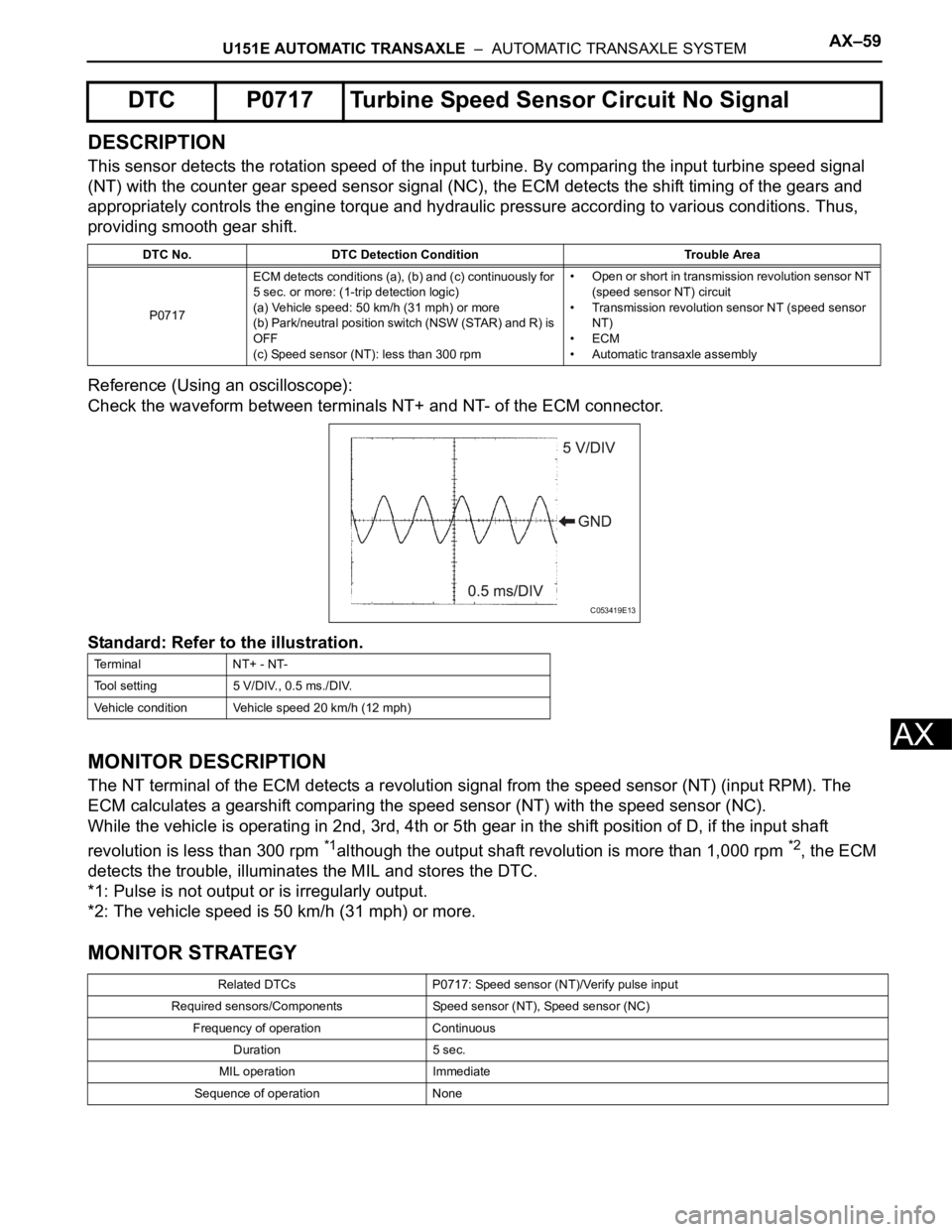
U151E AUTOMATIC TRANSAXLE – AUTOMATIC TRANSAXLE SYSTEMAX–59
AX
DESCRIPTION
This sensor detects the rotation speed of the input turbine. By comparing the input turbine speed signal
(NT) with the counter gear speed sensor signal (NC), the ECM detects the shift timing of the gears and
appropriately controls the engine torque and hydraulic pressure according to various conditions. Thus,
providing smooth gear shift.
Reference (Using an oscilloscope):
Check the waveform between terminals NT+ and NT- of the ECM connector.
Standard: Refer to the illustration.
MONITOR DESCRIPTION
The NT terminal of the ECM detects a revolution signal from the speed sensor (NT) (input RPM). The
ECM calculates a gearshift comparing the speed sensor (NT) with the speed sensor (NC).
While the vehicle is operating in 2nd, 3rd, 4th or 5th gear in the shift position of D, if the input shaft
revolution is less than 300 rpm
*1although the output shaft revolution is more than 1,000 rpm *2, the ECM
detects the trouble, illuminates the MIL and stores the DTC.
*1: Pulse is not output or is irregularly output.
*2: The vehicle speed is 50 km/h (31 mph) or more.
MONITOR STRATEGY
DTC P0717 Turbine Speed Sensor Circuit No Signal
DTC No. DTC Detection Condition Trouble Area
P0717ECM detects conditions (a), (b) and (c) continuously for
5 sec. or more: (1-trip detection logic)
(a) Vehicle speed: 50 km/h (31 mph) or more
(b) Park/neutral position switch (NSW (STAR) and R) is
OFF
(c) Speed sensor (NT): less than 300 rpm• Open or short in transmission revolution sensor NT
(speed sensor NT) circuit
• Transmission revolution sensor NT (speed sensor
NT)
•ECM
• Automatic transaxle assembly
Te r m i n a l N T + - N T -
Tool setting 5 V/DIV., 0.5 ms./DIV.
Vehicle condition Vehicle speed 20 km/h (12 mph)
Related DTCs P0717: Speed sensor (NT)/Verify pulse input
Required sensors/Components Speed sensor (NT), Speed sensor (NC)
Frequency of operation Continuous
Duration 5 sec.
MIL operation Immediate
Sequence of operation None
C053419E13
Page 1426 of 3000
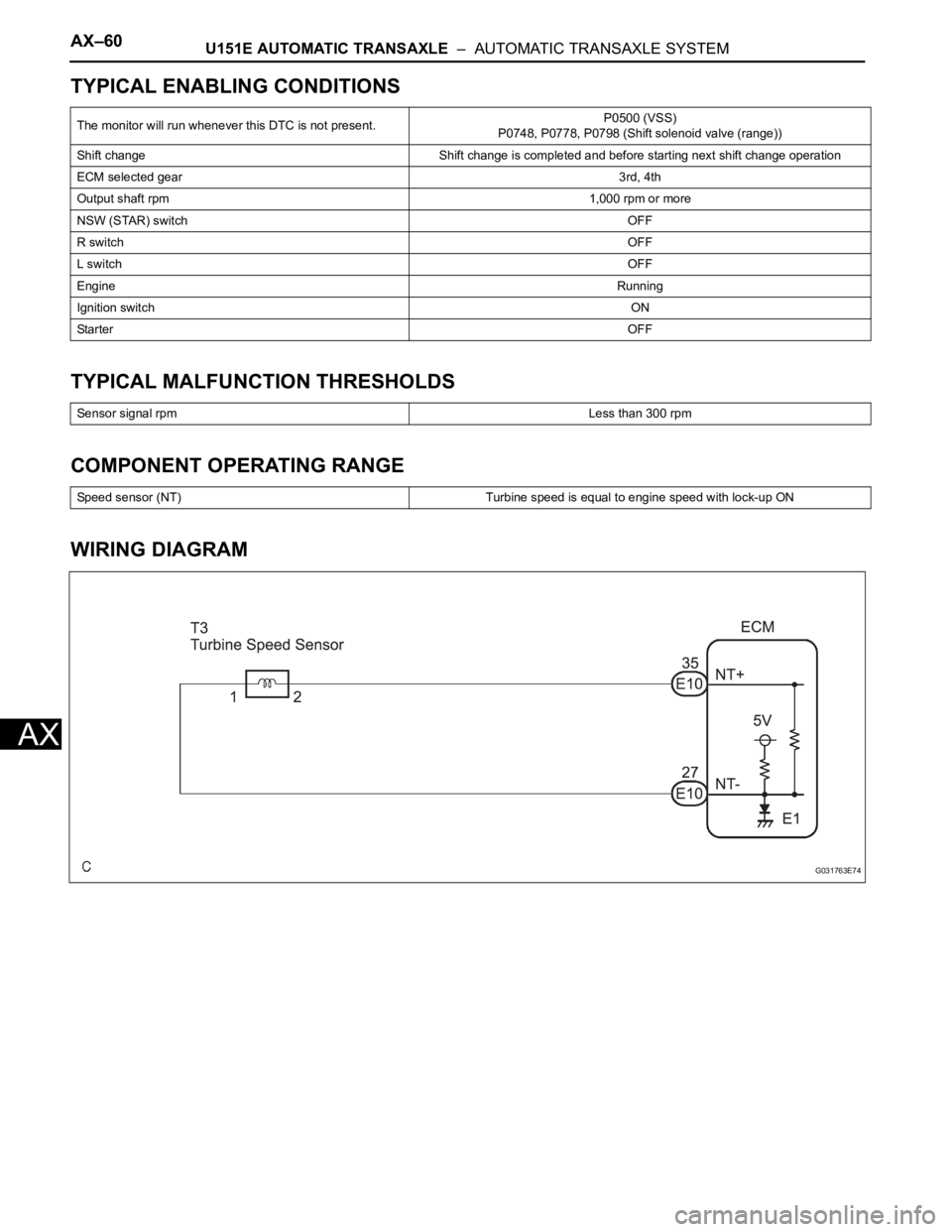
AX–60U151E AUTOMATIC TRANSAXLE – AUTOMATIC TRANSAXLE SYSTEM
AX
TYPICAL ENABLING CONDITIONS
TYPICAL MALFUNCTION THRESHOLDS
COMPONENT OPERATING RANGE
WIRING DIAGRAM
The monitor will run whenever this DTC is not present.P0500 (VSS)
P0748, P0778, P0798 (Shift solenoid valve (range))
Shift change Shift change is completed and before starting next shift change operation
ECM selected gear3rd, 4th
Output shaft rpm1,000 rpm or more
NSW (STAR) switchOFF
R switchOFF
L switchOFF
EngineRunning
Ignition switchON
StarterOFF
Sensor signal rpmLess than 300 rpm
Speed sensor (NT) Turbine speed is equal to engine speed with lock-up ON
G031763E74
Page 1427 of 3000
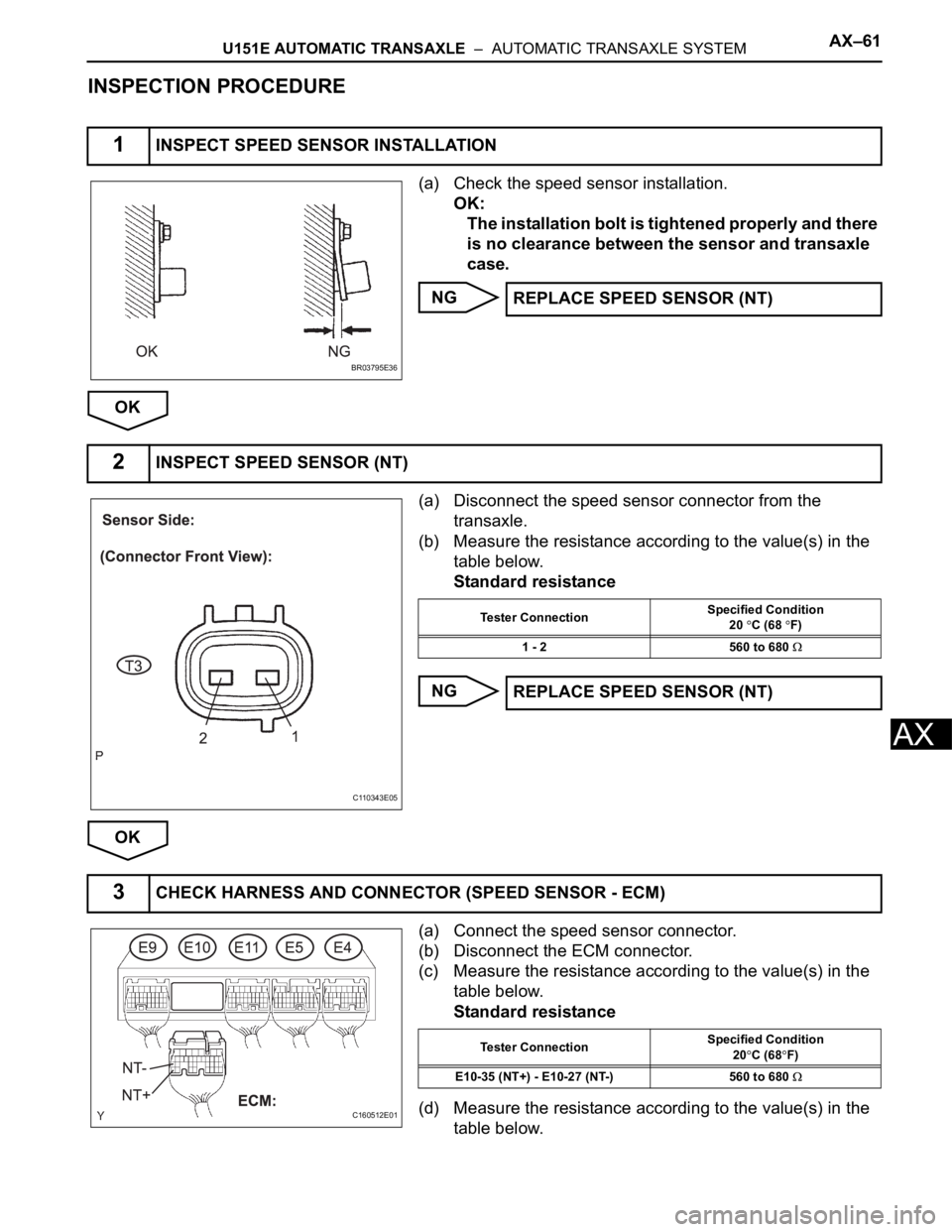
U151E AUTOMATIC TRANSAXLE – AUTOMATIC TRANSAXLE SYSTEMAX–61
AX
INSPECTION PROCEDURE
(a) Check the speed sensor installation.
OK:
The installation bolt is tightened properly and there
is no clearance between the sensor and transaxle
case.
NG
OK
(a) Disconnect the speed sensor connector from the
transaxle.
(b) Measure the resistance according to the value(s) in the
table below.
Standard resistance
NG
OK
(a) Connect the speed sensor connector.
(b) Disconnect the ECM connector.
(c) Measure the resistance according to the value(s) in the
table below.
Standard resistance
(d) Measure the resistance according to the value(s) in the
table below.
1INSPECT SPEED SENSOR INSTALLATION
BR03795E36
REPLACE SPEED SENSOR (NT)
2INSPECT SPEED SENSOR (NT)
C110343E05
Tester ConnectionSpecified Condition
20 C (68 F)
1 - 2 560 to 680
REPLACE SPEED SENSOR (NT)
3CHECK HARNESS AND CONNECTOR (SPEED SENSOR - ECM)
C160512E01
Tester ConnectionSpecified Condition
20C (68F)
E10-35 (NT+) - E10-27 (NT-) 560 to 680
Page 1428 of 3000

AX–62U151E AUTOMATIC TRANSAXLE – AUTOMATIC TRANSAXLE SYSTEM
AX
Standard resistance (Check for short)
NG
OK
Tester Connection Specified Condition
E10-35 (NT+) - Body ground
10 k
or higher
E10-27 (NT-) - Body ground
REPAIR OR REPLACE HARNESS OR
CONNECTOR
REPLACE ECM
Page 1429 of 3000

U151E AUTOMATIC TRANSAXLE – AUTOMATIC TRANSAXLE SYSTEMAX–63
AX
DESCRIPTION
The purpose of this circuit is to prevent the engine from stalling while driving in lock-up condition when
brakes are suddenly applied.
When the brake pedal is depressed, this switch sends a signals to the ECM. Then the ECM cancels the
operation of the lock-up clutch while braking is in progress.
MONITOR DESCRIPTION
This DTC indicates that the stop light switch remains on. When the stop light switch remains ON during
"stop and go" driving, the ECM interprets this as a fault in the stop light switch and the MIL comes on and
the ECM stores the DTC. The vehicle must stop (less than 3 km/h (2 mph)) and go (30 km/h (19 mph) or
more) 5 times for two driving cycles in order to detect a malfunction.
MONITOR STRATEGY
TYPICAL ENABLING CONDITIONS
TYPICAL MALFUNCTION THRESHOLDS
DTC P0724 Brake Switch "B" Circuit High
DTC No. DTC Detection Condition Trouble Area
P0724The stop light switch remains ON even when the
vehicle is driven in a STOP (less than 3 km/h (2 mph)
and GO (30 km/h (19 mph) or more) fashion 5 times. (2-
trip detection logic).• Short in stop light switch circuit
• Stop light switch
•ECM
Related DTCs P0724: Stop light switch/Rationality
Required sensors/Components Stop light switch, Vehicle speed sensor
Frequency of operation Continuous
Duration GO and STOP 5 times
MIL operation 2 driving cycles
Sequence of operation None
The monitor will run whenever this DTC is not present. None
Ignition switchON
Sta r t e rOFF
Battery voltage8 V or more
GO (Vehicle speed is 30 km/h (18.63 mph) or more) Once
STOP (Vehicle speed is less than 3 km/h (1.86 mph)) Once
Brake switch Remain ON during GO and STOP 5 times
Page 1430 of 3000
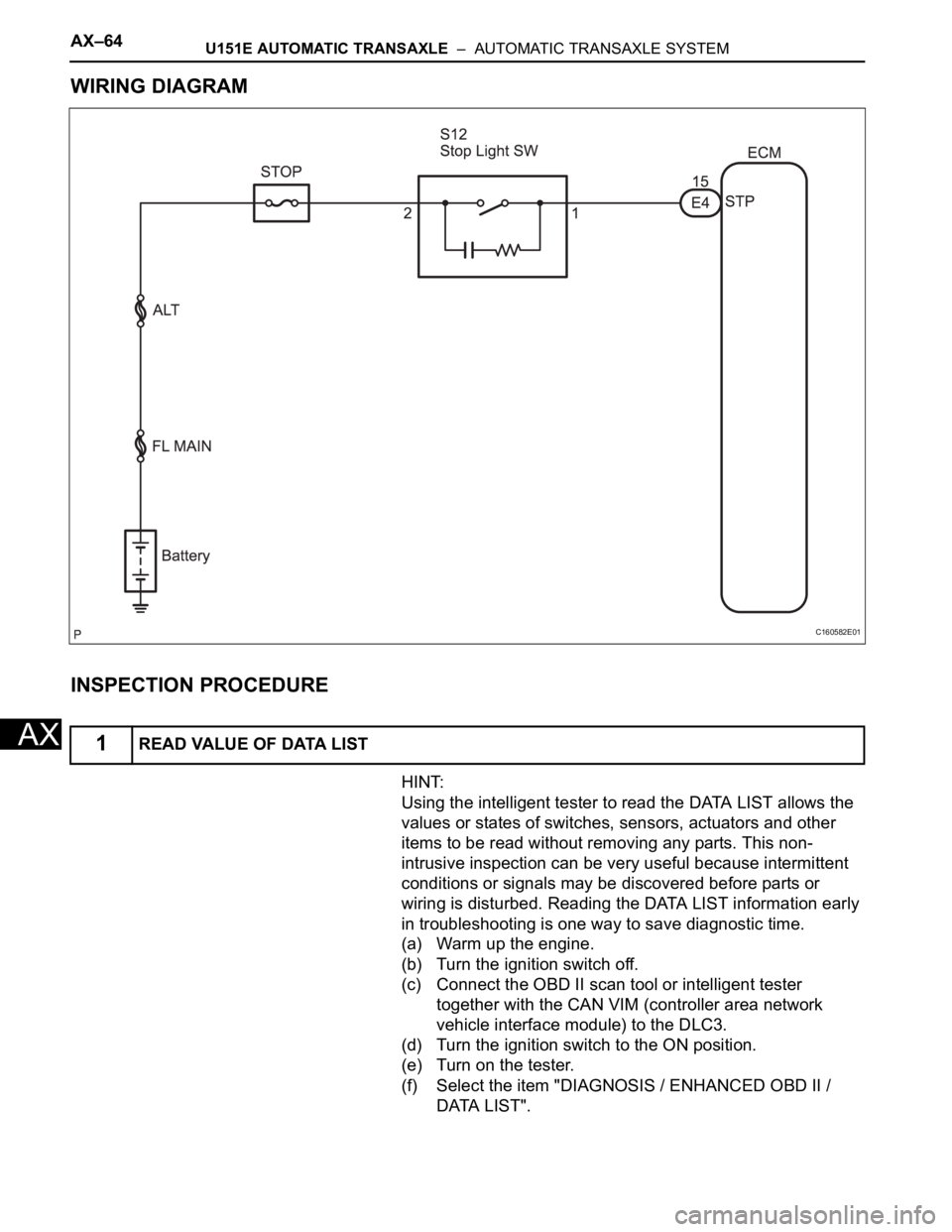
AX–64U151E AUTOMATIC TRANSAXLE – AUTOMATIC TRANSAXLE SYSTEM
AX
WIRING DIAGRAM
INSPECTION PROCEDURE
HINT:
Using the intelligent tester to read the DATA LIST allows the
values or states of switches, sensors, actuators and other
items to be read without removing any parts. This non-
intrusive inspection can be very useful because intermittent
conditions or signals may be discovered before parts or
wiring is disturbed. Reading the DATA LIST information early
in troubleshooting is one way to save diagnostic time.
(a) Warm up the engine.
(b) Turn the ignition switch off.
(c) Connect the OBD II scan tool or intelligent tester
together with the CAN VIM (controller area network
vehicle interface module) to the DLC3.
(d) Turn the ignition switch to the ON position.
(e) Turn on the tester.
(f) Select the item "DIAGNOSIS / ENHANCED OBD II /
DATA LIST".
1READ VALUE OF DATA LIST
C160582E01